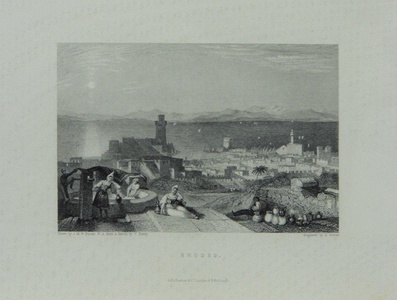| Method | Steel engraving |
| Artist | Samuel Fisher after Joseph Mallord William Turner and Charles Barry |
| Published | A. Fullarton & Co. London & Edinburgh. [c. 1856] |
| Dimensions | Image 93 x 140 mm, Sheet 176 x 259 mm |
| Notes |
From the Royal Geographical Society's A Gazetteer of the World, or Dictionary of Geographical Knowledge (London: A. Fullarton & Co., 1856). Samuel Fisher (1806 - 1851) was a British engraver best known for his topographical scenes. Joseph Mallord William Turner (1775 - 1851) was a painter and draughtsman who became one of the most celebrated artists Britain would ever produce. He was born near Covent Garden, London, and entered the Royal Academy Schools in December of 1789. The Academy, conscious of his prodigious talent, encouraged and supported Turner. He was elected as an Associate of the RA in 1799, and became a full Academician in 1802. His early oil painting flitted between Netherlandish works in the manner of Cuyp, Ruisdael and Van de Velde; classical landscapes like those of Claude and Richard Wilson; and, upon returning from his Parisian visit in 1802, grand historical compositions like those of Poussin and Titian. The development of his idiosyncratic style, commonly held to have been around 1803, led to critical condemnation. His preoccupation with light and colour produced abstract, near vorticistic works, which predated Impressionism, but were hugely controversial in the conformist context of late Georgian and early Victorian England. Whilst some critics accused Turner of extravagance and exaggeration, John Ruskin virulently thwarted these claims in Modern Painters, and championed the artist's fidelity to nature. Ruskin became the main advocate of a new generation of Turner admirers, usually professional, middle class or newly wealthy, who embraced his work for its modernity. An enormously prolific artist, Turner bequeathed over three hundred oils and close to twenty thousand drawings and prints to the nation. His style produced many imitators, but no rivals. Sir Charles Barry FRS (1795 - 1860) was an English architect, best known for his role in the rebuilding of the Houses of Parliament during the mid-nineteeth century. He was a supporter of Italianate architecture in Britain, particularly the use of the Palazzo as the basis for the design of country houses, city mansions and public buildings. Archibald Fullarton and Company were a Glasgow based publisher operating towards the end of the nineteenth century. The company produced a number of atlases, and books containing attractively decorated maps, including Fullarton's Parliamentary Gazetteer Of England And Wales and The Royal Illustrated Atlas, Of Modern Geography. Condition: Small stain in top right corner of sheet, not affecting image. |
| Framing | unmounted |
| Price | £30.00 |
| Stock ID | 30613 |

